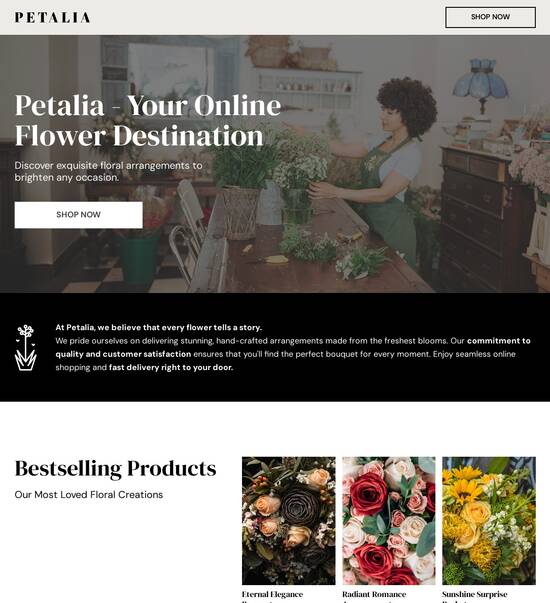
HTML page template for shoes stores
Use TemplateAbout template
Showcase your products with stunning landing page templates for your shoes stores. Ready to boost those sales?
Recommended templates

Easy to build without coding
With the intuitive drag-and-drop builder, anyone on your team can create high-converting pages without any knowledge of code or design. Make enhancements to your landing page with custom widgets using Javascript, HTML/CSS, or third-party scripts.

Multiple layouts for any industry and goal
Select from 500+ landing page layouts built to boost conversions across industry-specific scenarios. Customize them by adjusting fonts, adding images, and generating on-brand content with the AI assistant. Quickly scale with Instablocks® and Global Blocks that you can save, reuse, and update globally.

Loads fast and looks polished on any device
Every template is responsive, which means they present professionally on any device and load blazingly fast with our Thor Render Engine. You can also power them up with Google AMP technology to deliver an unparalleled mobile experience and drive higher conversions.

Robust analytics & experimentation
Get real-time updates and reporting across all your devices, showing the number of visitors, conversions, cost-per-visitor, and cost-per-lead. Launch AI-powered experiments, run A/B tests, and use heatmaps to analyze user behavior, then optimize your landing page to maximize conversions.







Easy to build without coding
With the intuitive drag-and-drop builder, anyone on your team can create high-converting pages without any knowledge of code or design. Make enhancements to your landing page with custom widgets using Javascript, HTML/CSS, or third-party scripts.
Multiple layouts for any industry and goal
Select from 500+ landing page layouts built to boost conversions across industry-specific scenarios. Customize them by adjusting fonts, adding images, and generating on-brand content with the AI assistant. Quickly scale with Instablocks® and Global Blocks that you can save, reuse, and update globally.
Loads fast and looks polished on any device
Every template is responsive, which means they present professionally on any device and load blazingly fast with our Thor Render Engine.
Robust analytics & experimentation
Get real-time updates and reporting across all your devices, showing the number of visitors, conversions, cost-per-visitor, and cost-per-lead. Launch AI-powered experiments, run A/B tests, and use heatmaps to analyze user behavior, then optimize your landing page to maximize conversions.
All the features you need to build recommendations for platforms offering limited edition templates for sneaker customization
Explore more featuresLearn how to build footwear website templates
Frequently asked questions about shoes website template
Leading the way in building high-performing landing pages





Shoes website templates: Your ultimate how-to guide
Optimizing landing pages is critical for digital marketers aiming to maximize conversions and ROI. Instapage stands out as the foremost landing page and conversion rate optimization platform, offering powerful tools that streamline the entire process, from creation to optimization. This guide will walk you through leveraging Instapage's features to elevate your marketing campaigns effectively.
Understanding the basics of landing page optimization
Landing page optimization involves various techniques aimed at increasing the effectiveness of your pages. With Instapage, you can start by using over 100 customizable templates that are geared toward driving conversions. Each template is designed to engage visitors immediately, making it easier for your audience to find the information they need, leading them to take action. This understanding sets the groundwork for all subsequent steps.
- Customizable templates: Save time with pre-designed layouts that can be modified to fit your branding.
- Lead generation elements: Integrate forms and call-to-action buttons seamlessly with intuitive drag-and-drop features.
- A/B testing capabilities: Experiment with different versions of your landing pages to determine which works best.
Creating your landing page using Instapage
Begin by selecting a template that aligns with your marketing objectives. Instapage's intuitive builder allows you to customize your page’s layout and content without the need for coding knowledge.
- Choose a relevant template that reflects your offer.
- Utilize Instablocks—reusable sections that can be saved and applied across multiple pages.
- Incorporate lead capture forms to ensure you can collect visitor information effectively.
Utilizing optimization features for better results
Discovering how to optimize your landing pages is crucial for maximizing their performance. Instapage provides built-in tools for analytics that deliver insights into user behavior.
- Heatmaps: Analyze where visitors are clicking and scrolling to enhance page layout.
- A/B testing: Use this feature to test variations of headlines or images to see which generates the highest conversion rate.
- Real-time feedback: Utilize collaboration features to get input from team members or stakeholders for continual improvements.
After implementing changes based on your insights, continuously monitor your landing page performance to adapt your strategies accordingly.
In conclusion, harnessing the capabilities of Instapage allows marketers to craft landing pages that are not only visually appealing but also conversion-centric. Adopting these practices will lead to improved campaign performance and higher ROI.
Start transforming your landing pages today with Instapage’s optimized tools and templates; sign up for a free trial and see the results for yourself.
The evolution of shoe stores on the web: unpacking HTML page templates
The shift to digital: understanding the e-commerce landscape for shoe stores
The retail landscape for shoe stores has undergone a significant transformation in recent years due to the rapid rise of e-commerce. Statistically, online shopping has seen consistent growth with estimates indicating that over 20% of total retail sales occur online. This trend is even more pronounced in the footwear sector, where consumers increasingly prefer the convenience of purchasing shoes from their homes. As shopping habits evolve, shoe stores must adapt to meet these changing expectations.
Today's consumers interact with online shoe stores in various ways, including browsing from mobile devices, seeking product details, and reading user reviews before making a purchase. An effective online presence is crucial for success in this competitive environment, as users' first interactions with your brand often occur on your website. This makes it essential to deploy a well-designed HTML page template that showcases your products and provides a seamless shopping experience.
Key components of an effective shoe store HTML page template
Responsive design
A mobile-optimized template is essential as more consumers shop on their smartphones. Examples include frameworks like Bootstrap or templates specifically designed for mobile users.
Aesthetic appeal
The right color schemes and typography can greatly enhance visual engagement. High-quality product images are crucial for convincing customers to finalize their purchases.
User experience
Clear navigation and categorized product listings simplify the shopping process, leading to increased user satisfaction and potentially higher conversion rates.
Innovative features of shoe store HTML templates
Modern shoe store HTML templates are equipped with various innovative features that enhance usability and engagement. One key element is dynamic product displays, where sliders and grid layouts can be used to showcase product collections effectively. This visual display not only highlights the shoes but also offers a more interactive shopping experience.
Another significant feature is built-in e-commerce functionality, allowing retailers to sell directly from their website. Integration with payment gateways such as PayPal or Stripe streamlines transactions. Additionally, effective inventory management systems ensure that stock levels are maintained without manual intervention, providing accurate product availability to customers.
Technical aspects: navigating the code behind the templates
Understanding the technical backbone of HTML templates is vital for shoe store owners who want to customize their online presence. The core technologies involved are HTML, CSS, and JavaScript. HTML structures the content, CSS styles the layout, and JavaScript manages interactive functionalities. Familiarity with these languages allows for effective customization of templates.
For example, you can create unique elements for your site with simple JavaScript snippets that can enhance user interaction. Additionally, proper cookie management techniques are essential for collecting user data, which aids in improving the overall shopping experience while adhering to privacy regulations.
A step-by-step guide to implementing your shoe store HTML template
Choosing the right template
Consider your current infrastructure, compatibility with existing systems, and how easily the template can be customized.
Downloading and setting up your HTML template
Follow the procedure for downloading and extracting your chosen template files, making sure to check for any hosting requirements to optimize site speed.
Customizing your template
Adjust visual elements, including branding colors and typography, to ensure consistency across your brand's online presence.
Testing the user experience
Use A/B testing strategies to determine the most effective designs and layout for enhancing customer interaction.
Enhancing customer engagement and retention
To boost customer engagement, shoe stores should integrate efforts such as email marketing and lead capture forms within their HTML templates. Capturing email addresses through unobtrusive pop-ups or subscription forms allows businesses to create targeted marketing campaigns that nurture leads and encourage repeat purchases.
Sharing brand stories enhances customer connections and establishes loyalty. Storytelling can be incorporated on product pages or dedicated landing sections—this could include narratives about product collections or the inspiration behind specific designs, creating a more profound emotional link between the brand and the customer.
Real-world examples: successful shoe stores using HTML templates
Analyzing successful case studies of shoe stores that have effectively leveraged HTML templates reveals critical insights into successful strategies. Leveraging features like user feedback tools, these brands showcase their products while actively engaging customers to share their experiences. Success stories often include detailed breakdowns of template elements—what worked, why it’s effective, and how to replicate those successes in different contexts.
Moreover, incorporating customer testimonials on landing pages can enhance trust. These stories not only validate the quality and appeal of the products but also influence potential buyers, affirming the brand's reliability through social proof.
Future of shoe store e-commerce: innovations on the horizon
As the e-commerce landscape evolves, several trends are emerging that will shape the future of HTML template development for shoe stores. With heightened emphasis on responsive design and user-friendly interfaces, templates will continue focusing on interactivity to enhance shopper engagement. Anticipating these trends will help businesses stay ahead of the curve, ensuring they meet customer expectations.
Integration of emerging technologies like augmented reality (AR) and artificial intelligence (AI) into shopping experiences is also on the rise. AR can provide customers with immersive displays, allowing them to visualize how shoes would look when worn, while AI can offer personalized shopping experiences based on user behaviors and preferences. These innovations promise to enhance user engagement significantly.
Conclusion: embracing digital transformation in footwear retail
The transition towards digital retail is an opportunity rather than a challenge for shoe stores. By effectively adopting HTML templates tailored for e-commerce, retailers can strengthen their online presence, attract more customers, and increase overall sales. The landscape continues to evolve, and those who innovate and adapt are positioned to thrive in the ever-competitive market of footwear retail.
Ready to skyrocket conversions?
Supercharge your ad campaigns with high-performing landing pages
Get started














